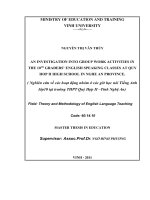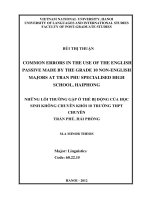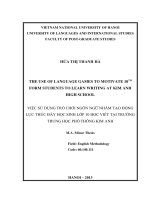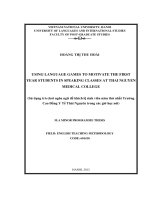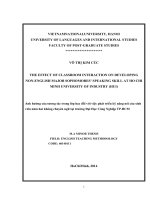The use of cooperative learning to motivate student grade 10 in speaking classes at tinh gia 4 high school
Bạn đang xem bản rút gọn của tài liệu. Xem và tải ngay bản đầy đủ của tài liệu tại đây (782.7 KB, 21 trang )
DEPARTMENT OF THANH HOA EDUCATION AND TRAINING
TINH GIA 4 HIGH SCHOOL
EXPERIENCE INITIATIVE
THEME:
THE USE OF COOPERATIVE LEARNING TO
MOTIVATE STUDENT GRADE 10 IN SPEAKING
CLASSES AT TINH GIA 4 HIGH SCHOOL
Written by :Phùng Thị Hậu
Position: Teacher
Subject:English
THANH
2019
TABLE
OF HOA
CONTENTS
2
1.INTRODUCTION
PAGE
02
1.1. Rationale of the study
02
1.2. Aims of the study
02
1.2.1. Research questions
02
1.2.2. Definition of specific terms
03
1.3. Scope of the study
03
1.4.Methodology and research schedule
03
1.4.1. Independent and dependent variables
03
1.4.2. Research design
03
1.4.3. Data collection procedures
04
2.CONTENTS
04
2.1. Literature review
04
2.2. Selection of the subjects
05
2.3. Methods
06
2.3.1. Interviews
06
2.3.2. Lesson plans
06
2.3.3. Classroom observation
14
2.3.4.Teacher’s diaries
14
2.3.5. Student questionnaire
14
2.4. Data analysis
14
2.4.1. Research schedule
15
2.4.2. Results of experimental group’s participation
15
2.4.3.Expected findings
16
3. CONCLUSION AND SUGGESTION
16
3.1.Conclusion
16
3.2. Suggestion
17
REFERENCES
18
APPENDIX
19
3
1.INTRODUCTION
1.1. Rationale of the study
Nowadays, English is very important because it is the only language that
truly links the whole world together.Innovitiating teaching method is considered
as a vital part in the whole process of teaching development strategies. There is
no doubt that motivation is at the heart of successful language learning, but how
to motivate a learner to learn a language effectively seems to be a difficult
question for all teachers of English. A common problem for EFL teachers is to
deal with a passive class, where students are unresponsive and avoid interaction
with the teacher and even among themselves.
During my working time as a teacher of English at Tinh Gia 4 High
School, I realized that my students have met difficulty in oral communication
classes. This is, as recognized, due to their little motivation in the English oral
classes. Many of my students usually find no interest in speaking English even
they are asked to do and some, in other cases, feel less confident when they use
English to interact among class members because of their limited language
ability. Therefore, I have tried lots of possible teaching methods in oral class so
as to probably change the current situation. Among many teaching techniques
for speaking skill I found out that cooperative learning strategy, as group-work
learning, has lots of interesting activities from which my students can benefit in
English oral classes, for they will get more confidence and chances as well to
express their ideas and opinions among group members. My students will feel
more motivated when they have chances to engage in a variety of speaking
activities such as round robin, three-step-interview [Spencer Kagan], team
jigsaw [Sikes and Snap 1978] or group investigation, etc. By using teaching
method of this kind, I hope that my students’ attitude towards English oral class
will make a lot of positive changes. They, to large extent, become more activated
and ready to work hard to master their speaking skill in all oral communication
classes. Therefore, I decided to apply“The use of cooperative learning to
motivate students grade 10 in speaking classes at Tinh Gia 4 High School”
as the topic of my research.
1.2.Aims of the study
The research was carried out with 10 th graders at Tinh Gia 4 High School.
The main objective of the research was to establish strategies to help students to
improve their oral ability in English. Instruments used to collect the data were:
lesson plans, student questionnaire, teacher’s notes , diary and interviews.
Considering the data gathered, this research prompted a more cooperative
environment among students in the oral process. Furthermore ,it was a way to
motivate other teachers in the school to apply these kinds of strategies in
speaking lesson.
1.2.1 Research questions
This study is carried out to find the answer to the following questions:
1. Why do our students become unmotivated in oral communication
classroom?
4
2. What benefits of cooperative learning can our students get?
3. What can we do to improve their motivation in speaking classes?
1.2.2. Definition of specific terms
+ Cooperative Learning: The instructional use of small groups so that students
work together to maximize their own and each other’s learning [Johnson &
Johnson, 1993-1].
+ Motivation: Motivation is defined as the impetus to create and sustain
intensions and goal seeking acts [Ames & Ames, 1989-2].
1.3. Scope of the study
Within this study, I concentrated on investigating and discovering
obstacles or difficulties encountered with students in English speaking lessons
at Tinh Gia 4 high school. From these findings, the internal and external causes
are analysed to give some suggestions for tackling them in order to motivate
students and help improve students’ speaking skill.
The study was conducted on the students of grade 10 at Tinh Gia 4 high
school with the textbook “Tiếng Anh 10”.
1.4.Methodology and research schedule
1.4.1. Independent and dependent variables
To motivate
students in
speaking classes
The use of
cooperative
learning
Operational definition:
Teacher uses the cooperative
learning approach to help
motivate students to speak
English in the class
Operational definition:
Students get motivated and
more confident in English
speaking classes.
1.4.2. Research design
Research Questions
1. Why do our students
become unmotivated in
oral communication
Research
Instruments
- interviews
- Teacher’s lesson
Subjects
- Grade 10
- Age: 16
- Level: Pre-
Tools for
analysis
- Frequency
count
5
classroom ?
2. What benefits of
cooperative learning can
our students get ?
3. What can we do to
improve their motivation
in speaking classes ?
plans
intermediate
- class observations - School name:
Tinh Gia 4 high
- teacher’s diaries
school
- Student
questionnaires
- Sample size:
90 students
- Percentage
- Critical
discourse
analysis of
classroom
observation.
1.4.3. Data collection procedures
The Data collection procedure is indicated in the following chart.
Pre-intermediate 10
graders
Interviews
Classroom observation
The use of cooperative learning
Classroom observation
Analysis of classroom observation notes
Students’ Questionnaires
2.CONTENTS
2.1. Literature review
According to Cohen 1994 and Weidner 2003[3- page 33], Cooperative
learning can be characterized as a social process in which knowledge is acquired
through the successful interaction between the group members. Also, Slavin
1995[4 - page 2] said cooperative learning refers to variety of teaching methods
in which students work in small groups to help one another learn academic
content. In cooperative classrooms, students are expected to help each other, to
6
discuss and argue with each other, to access each other’s current knowledge and
fill in gaps in each other’s understanding.
Learners, on the one hand, can gain such great achievements, social
benefits and economic benefits through cooperative learning, which is seen as
key changes in societies Weidner 2003[5 - page 18-25]. Obviously, more
learners can probably become the winners by joining in cooperative learning and
sharing the success of achievements among them, [Slavin -1984]. Cooperative
learning produces greater student achievement than traditional learning
methodologies [Slavin 1984]. Low achieving students when grouped with higher
achieving students tend to be more hard-working, for there is a competition
among groups in cooperative learning. Likewise, one of the essential elements
of cooperative learning is the development of social skills. Besides academic
benefits, learners can retrieve social benefits, which can be understood in a way
that those who collaboratively work can know how to cooperate with others.
Much has been learnt from others’ viewpoints other than from their own. Social
interaction improves communication skills that become a necessity to
functioning in society. Last but not least, cooperative learning requires fewer
materials as learners can share among other group members. Less equipment is
necessary so learners can save money without sacrificing the quality of
education.
Teachers, as a role of a coach, a facilitator, and sometimes a spectator in
this approach, are also the beneficiaries from the cooperative learning. By
applying cooperative teaching method, teachers can probably save their time for
their target lessons. This is due to the fact that when the classrooms are well
organized students will work more effectively rather than one that is clutter.
With traditional teaching methodologies, students sit in pre-arranged rows. Class
members may be of oversize. Cooperative learning works best when group size
is of smaller clusters of about 3 or 4 students. Furthermore, teachers become
more interactive with each cluster during the class time. He/ she can easily
manage group work or monitor group actions and behaviors, for all activities are
well prepared in advance. Finally, teachers can no longer be under increasing
pressure to work with each individual, which possibly put them into stress in
some way.
In summary, cooperative learning approach has far and away proved itself
as an effective way to motivate learners in EFL classroom in comparison with
other teaching techniques or approaches. Thus, it is the teachers that should
know when and how to use it in their classrooms in order that the lessons are
better taught and the learners will benefit more from the teacher’s teaching.
2.2. Selection of the subjects
The research is carried out to see how effectively my students interact in
English speaking classes and how well they speak English when the cooperative
learning approach is applied in the teaching of speaking. Our subjects are 10 th
graders who are studying in Tinh Gia 4 High School. Our teaching is conducted
7
with 90 students from classes 10C1, 10C4, who are 15-16 years of age.
Although those students are best selected from the Entrance Examination, they
seem not to be good at speaking English. It is due to the fact that the annual
exams are designed to focus on only English grammar, reading and writing but
not listening and speaking skills. As a consequence, they are in the state of being
timid in oral classes. For this reason, I decided to use cooperative learning
approach as a method to motivate my students to learn how to speak English
effectively in the classrooms.
2.3.Methods
2.3.1. Interviews (See APPENDIX)
Interviews are carried out to see how my students feel about the English
oral classes and to find out what difficulties they are coping with. I interviewed
my colleagues and other 85 students to see their viewpoints from which I
probably choose a suitable method for my teaching.
Factors that prevent students from taking part in speaking activities
What factors prevents you from participating in speaking activities
Numbers %
(90 Ss)
Factors
a. Speaking activities are difficult because I don’t have
enough words to speak.
b. Be shy and fear of mistakes and derision
c. Speaking activities are not interesting, the topics are
boring
d. The teacher doesn’t encourage speaking
50
55%
20
22%
15
17%
5
6%
2.3.2. Lesson plans
Lesson plans play a crucial role in language teaching approach. They helps
teacher know what and how to teach his or her students. Hence, it is essential
that I collect lesson plans as a data source for my Action Research.
Basing on the textbook “Tieng Anh 10” , we choose some of the speaking
periods to design my target lesson plans in a way that the cooperative learning
can probably be applied and easily observed. Below are some cooperative
learning techniques to be applied in my teaching of English speaking.
UNIT 4: SPECIAL EDUCATION
Period 22:
Lesson B.Speaking
Activity 1:Network - Brainstorming
- T. gives out the network below and asks Ss to think of the questions used to
ask about the information in it.
8
THE
THINGS
YOU DON’T
LIKE
THE
THINGS
YOU LIKE
NAME OF
SCHOOL
THE
HOMEWORK
SCHOOL
LIFE
TESTS &
EXAMINATIONS
TIMETABLE
SUBJECTS
- T. calls on some students to give their answers
Eg: 1. Which lower –secondary school did you go to?
What is the name of the secondary school you went to?
2. What were your subjects then?
Can you name the subjects then?
3. What was your timetable?
Did you go to school in the morning or in the afternoon?
4. What about your homework?
Did you have to do a lot of homework?
5. Can you tell me about the tests and examinations at your school then?
What kinds of tests and examinations did you have then?
6. What did you like best about your school then?
What made you like best about your school then?
7. What part of the school life didn’t you like then?
What didn’t you like about your school?
Activity 2: Role playing
- Students work in pairs,
- One student plays the role of an interviewer to ask the other the questions
about his/ her school life, using the information in the network.
- The interviewer will take notes the information for later reporting.
Activity 3: Reporting
-Using the network and the information in activity 2, the student who plays the
role of the interviewer will report what he/she has interviewed his/her friend.
Eg: I’ve talked to Nam. He went to Hai An lower-secondary school. At school,
he had to learnt 10 subjects such as: Maths, Literature, History, English,
Geography,…. Among these subjects, he like English best because …………..
9
UNIT 5:
TECHNOLOGY AND YOU
Period 27:
Lesson B. Speaking
Activity 1: Brainstorming
- T. gives out a real object (A CELL PHONE) and asks student the question
about its use.
Can/ Could you tell me what a cell
phone is used for?
- Well, it is used to talk to people
when you are away from home.
Can/ Could you tell me what
a ……..is used for?
- It is used to V(inf).
- On the screen, T shows the pictures of some modern inventions and then
asks students to work in pairs, asking and answering about their uses.
Activity 2:Reporting
This is a free activity and aims to develop fluency in speaking. The procedure
may be:
-Divide students into groups of four or five.
10
-Read through the instructions and make sure that each group understands
what to do. Choose one “secretary” in each group to write the list but emphasis
that everyone in the groups should agree on what to write.
-While the activity is going on, move from groups, but do not interrupt
more than is necessary.
-When some groups have finished their discussion, stop the activity, ask
one person from each group to report on what they decided
Give feedback: - Content
- Popular mistakes
UNIT 6: AN EXCURSION
Lesson B.Speaking
Period 33:
Activity 1: Role playing
-Teacher sets the scene: Imagine our class is going to have a boat trip on West
Lake in Hanoi. Please think of the seat you want to take on the boat. Give the
reason why you choose to sit on that place.
USEFUL LANGUAGES:
- on the sundeck.
- In the sun
- On a boat
- Get sunburn
- take photographs
- travel sickness
- have a good view
- In turn, students talk about their favorite seat on the boat. Other students listen
and take note for later reporting.
Eg; S1: I don’t want to sit on the sundeck because I don’t want to get sunburn.
S2: I often offer from travel sickness, so I’d like the seat where I can get a
lot of fresh air.
S3: I want to have a good view on the board, so that I can take photograph
S4: I’d like to be by myself.
S5:……………
S6:…………..
Teacher: ……………….
Activity 2: Presenting
-Students work in groups of two tables, studying the seat plan and decide the
best seat for each person. (Each groups has a copy of the seat plan to fill in the
names of the students)
-After the groups have finished, T. asks one or two groups to present their
discussion in front of the class. After that the whole class to have a discussion to
make the final decision.
Activity 3: Presenting
T. asks students to work in groups of the same table to talk about the best seat
for the six students mentioned in activity 2.
11
Unit 8: THE STORY OF MY VILLAGE
Period 46 :
Lesson B.Speaking
Activity: Role-play and discussion
Procedure:
Teacher’s activities
Students’ activities
I. Pre-speaking:
- Shows a picture of Ha Xuyen village.
- Students do in groups of
three or fours.
- Each member in the group
is asked to play a role as a
village planner. They are
going to talk about the
advantages and
disadvantages of
reconstruction plan of their
village.
- Asks students to look at the pictures and suggestion to
talk about Ha Xuyen village.
- Each group is given some
suggestions for their talks.
- Students are required to
present in front of the class
after their practicing in the
groups.
Road/ narrow
- Others look at the screen
and correct
School/ small and poor
+ There/ no bridge/ in Ha Xuyen village.
+ There/ no medical centre/ in Ha Xuyen village.
+ There/ no football ground/ in Ha Xuyen village.
- Raises the question:
12
What should we do to improve the life in the village?
- Leads in new lesson: Let’s practice talking about the
plans to improve the life in Ha Xuyen village and their
possible results.
II. While-speaking
Task 1:
The villagers of Ha Xuyen are discussing plans to
improve the life in the village. Look at the pictures and
say what they should do.
- Ask sts to practise in pairs before presenting in front of
the class.
- Discuss in pairs
- Take turns to talk about Ha
Xuyen village.
1. The road is narrow.
2. The school is small and
poor.
3. There is no bridge in Ha
Xuyen village.
4. There is no medical
centre in Ha Xuyen village.
5. There is no football
ground in Ha Xuyen village.
Now
- Practise speaking in pairs
- Take turns to talk .
In the future
They should widen the road.
Now
They should build a new
13
school.
In the future
Now
They should build a new
bridge.
In the future
14
In the future
They should build a medical
centre.
In the future
- Supposes students are Ha Xuyen villagers, give a
model:
A: What should we do to improve the life in the
village?
B: I think we should widen the road
- Gives more suggestion and asks students to produce
the similar conversations.
+ Widen the road
+ Build a new school
+ Build a bridge
+ Build a medical centre
+ Build a football ground
They should build a football
ground
- Read the model in chorus.
- Practice in pair
15
Unit 12: MUSIC
Period 76:
Lesson B.Speaking
Activity:Information gap
Procedures:
- The class is divided into groups of 4
- Each student is delivered a paper in which teacher designs a table. (See
appendix).
- Students have to interview their partners to get information as indicated in the
given table.
- After that, students are asked to report what they have got from partners in front of
the class.
Unit 16: HISTORICAL PLACES
Period 96:
Lesson B.Speaking
Activity : Group investigation
Procedure:
- The class is divided into groups of 5
- Students are required to prepare a presentation on a historical place they wish
to talk about. They are allowed to have one week for their preparations.
- Groups present their work in front of the class.
2.3.3. Classroom observation
I had our colleagues observe my speaking lessons and give us observation
notes as well as their feedback to see how our teaching of speaking activities
motivates our students so that we can get objective ideas for our lessons and
their reflection on the students’ motivation. Also, I asked our colleagues for
observing their teaching speaking lessons.
2.3. 4.Teacher’s diaries
Diaries are used to write down special notes and comments after each
speaking lesson to see what has been done effectively and what has not. By
doing this, I can know how well my teaching approach benefits our students so
that I may apply suitable strategies for my teaching methods.
2.3.5. Student questionnaire (See APPENDIX).
Through students’ questionnaire, I want to confirm the effectiveness of
my teaching approach. Students’ feedback is of great value from which I can
choose the most suitable methods to apply in my teaching and to help my
students learn better in all speaking classes.
2.4. Data analysis
Both quantitative and qualitative data are collected to support my
research. For the qualitative method, I did critical discourse analysis of teacher’s
classroom observation notes, lesson plans and diaries. Also, the quantitative
method is used to deal with students’ questionnaires which are analysed and
reported in a table as frequencies and percentages.
16
2. 4.1. Research schedule
Below is the timetable showing the exact time and stages when this study
is put into practice:
No.
Activities
Date to carry out
1
Keeping the traditional teaching method September, 2018 - week 1
for oral classes without using cooperative
learning approach
2
Prepare major focuses to interview
colleagues and students
October, 2018 - week 1-2
3.
Interviewing
October, 2018 – week 3 -4
4
Observing my colleagues’ classes and
asking colleagues to observe my classes.
November , 2018 – week 1-2
5
Using cooperative learning approach in
teaching speaking
Continuing the class observation to see
the students’ motivation in speaking
classes with cooperative learning
strategy.
Data analysis
November, 2018- week 3, 4
December,2018 - week 1, 2, 3, 4
January, 2019- week 3, 4
March, 2019 - week 1, 2, 3,
4
April, 2019 - week 1, 2
April, 2019 - week 3
6
7
8
10
Designing and running a questionnaire to April, 2019- Week 4
see students’ attitudes towards cooperative
learning strategy in oral classes.
Writing a report on how cooperative
May, 2019 - Week 1
learning can motivate students in oral
communication classrooms
2.4.2. Results of experimental group’s participation
+ Group 1: Control group
+ Group 2: Experimental group
2.4.2.1. Teacher’s talking time and students’ talking time in control and
experimental group before the experiment.
Time of speaking lesson
Experimental
(45’)
Control group
group
(10C1 + 10C4)
(10C1 + 10C4)
(90 students)
(90 students)
Teacher’s talking time
44,4%
55,6%
Students’ talking time
22,2%
22,2%
Silence
33,4%
22,2%
17
From given table ,we can see that the students’ participation in classroom
speaking activities was very poor. When talking with my students, I realized that
only about 10% of them were always willing to speaking in the class and they
are always shy when speaking English. They said that some speaking topics in
the textbook are too difficult and not communicative to them. They want to take
part in speaking activities with easier and more interesting topics.
2.4.2.2. Teacher’s talking time and students’ talking time in control and
experimental group after the experiment.
Time of speaking lesson
(45’)
Teacher’s talking time
Students’ talking time
Silence
Control group
(10C1 + 10C4)
(90 students)
40%
33,4%
26,6%
Experimental
group
(10C1 + 10C4)
(90 students)
22,2%
66,7%
11,1%
The data from the table shows that students’ talking time in experimental
group considerably increased compared to that figure of control group and
teacher’s talking time in trial group was reduced in comparison with that number
of the control group. The observation also reveals that the way I applied in
speaking lesson attracted a large number of students. They are not shy when
participating in speaking activities and interested in the games, pictures that
teacher gave them. The students are able to speak English in a real competitive
and friendly atmosphere. They are encouraged to speak English. They were
excited in some speaking activities such as role play, interview….From these
activities they can speak and understand English better.
2.4.3.Expected findings
Through the study,I do hope that the teaching strategy of using
cooperative learning in speaking classes will much benefit my students as they
have more chances to engage in speaking activities. Students who are timid, shy
and feel less motivated when joining in speaking classes of this kind will feel
more confident. More importantly, Competition among the groups was an
important factor to motivate students to work as a group, because it is important
for them to be the best and to be recognized. Students will be aware of their
responsibility in the speaking process. They should understand that one way to
improve speaking is practicing with others, interacting with others, and
learning from others.
3. CONCLUSION AND SUGGESTION
3.1.Conclusion
In this proposal, I have identified the problem and reviewed literature
related to my research field. Also, I have conducted data collection procedures
from different sources to support my study. we have planned out the timetable to
18
carry out my work in sequence. Having analyzed and worked through this
research project, we have concluded that cooperative learning strategies
helped students to improve oral production and interaction, but it was a
gradual process. I confirmed that speaking is a productive skill and it involves
many components.
Although this research work has successfully been conducted and has
helped to deal with the problems mentioned well, there are some drawbacks.
The first limitation is the scale of the study. This research work is only carried
out in my school. In fact, it could be conducted in a large scale with the same
knowledge and researching procedure. The next one is concerned with the scale
of survey questionnaires and observation with the enrollment of nearly a half of
the 10th form students and only 7 teachers of English at my school.
Moreover, in terms of data collection instruments, only two set of survey
questionnaires and observations are used. Without interview, I will not have
chance to listen directly to both the teachers and student’s ideas, so some
problems related to group work as perceived by them have been exploited.
To sum up, I hope that my research work will contribute a small part to
the teaching and learning English at school in general, especially the approach. I
hope it will help the teachers of English at school to teach and promote student’s
speaking competence.
3.2. Suggestion
What is presented on my personal opinions about additional practice English
speaking skills for students. To achieve high results in teaching combined with
having to meet the requirements and purposes of education at upper- secondary
school, I would strongly suggest some comments later:
Classroom layout should not exceed 30 students.
Invest more references, English books, enabling them to borrow books,
materials to self- study at home.
Sessions organize extracurricular activities, English exams or discuss the
topics in English to the students questioned, knowledge and hone their skills to
communicate their languages. English people have an idiom; “Practice makes
Perfect”.
The Headmaster’s identification
Thanh Hoa, 27th May, 2019
I ensure that this study has been written by
me, not coppied from someone else
The writer
Phùng Thị Hậu
19
REFERENCES
1. Artz, A. F., & Newman, C. M. (1990). Cooperative Learning. Mathematics
Teacher, 83, 448-449.
2. Gardner, R, Moorcroft, M. and Evers, F. 1987. Second language-attrition: the
role of motivation and use. Journal of Language and Social Psychology.
3. Johnson, D. W. (1991). Circles of learning. Cooperation in the classroom.
M.N. Interaction Book Company.
4. Johnson, D. W. (1988). Cooperation in the classroom. Edina: Interaction
Book Company.
5. Johnson, D., & Johnson, R. “Cooperative Learning.”
(Online) from />6. Kagan, S. (1986). Cooperative learning and socio-cultural factors in schooling.
California: California State University.
7. Nunan, D. (1989). Understanding language classrooms. New Jersey: Prentice
Hall.
8. Slavin, R. E. (1990). Cooperative learning: Theory, research and practice.
New Jersey: Prentice Hall
9. The text book and of English 10.
EXTRACTING FROM REFERENCES
[1] Johnson & Johnson, 1993
[2] Ames & Ames, 1989
[3] Cohen 1994 and Weidner 2003
[4] Slavin 1995
[5] Weidner 2003
[6] Some other metarial sources from my colleages and on the internet
-learning
20
APPENDIX
1. Factors that prevent students from taking part in speaking activities
What factors prevents you from participating in speaking activities
Numbers
%
Factors
(90 Ss)
a. Speaking activities are difficult because I don’t have
50
55%
enough words to speak.
b. Be shy and fear of mistakes and derision
20
22%
c. Speaking activities are not interesting, the topics are
15
17%
boring
d. The teacher doesn’t encourage speaking
5
6%
2. Speaking skill assesment form:
Assessor group: ...........................
Performance group: ....................................
Relevant to situation? ................................
Accuracy (grammar, pronunciation, word choice): ...........................
Fluency (hesitation, pauses, repetition): ...................
Strong points: .................................. ...........................
Weak points: ............................. ........................... ...........................
Comments: ............................ ............................. .............................
Total score: .............................................................
3. Interview
Ask your partners questions to get information to complete the table below:
Names
Things to ask
Partner 1:
Partner 2:
Partner 3:
Partner 4:
Kind of music
Reasons for
listening to music
Favorite band/
musician
Favorite songs
When
music
listen
to
21
Các SKKN đã đạt giải cấp ngành
STT
1
Tên đề tài
The use of pairwork and
groupwork to improve
speaking
skill
for
student at Tinh Gia 4
high school
Xếp loại
C
Cấp
Tỉnh
Năm
2016
22

